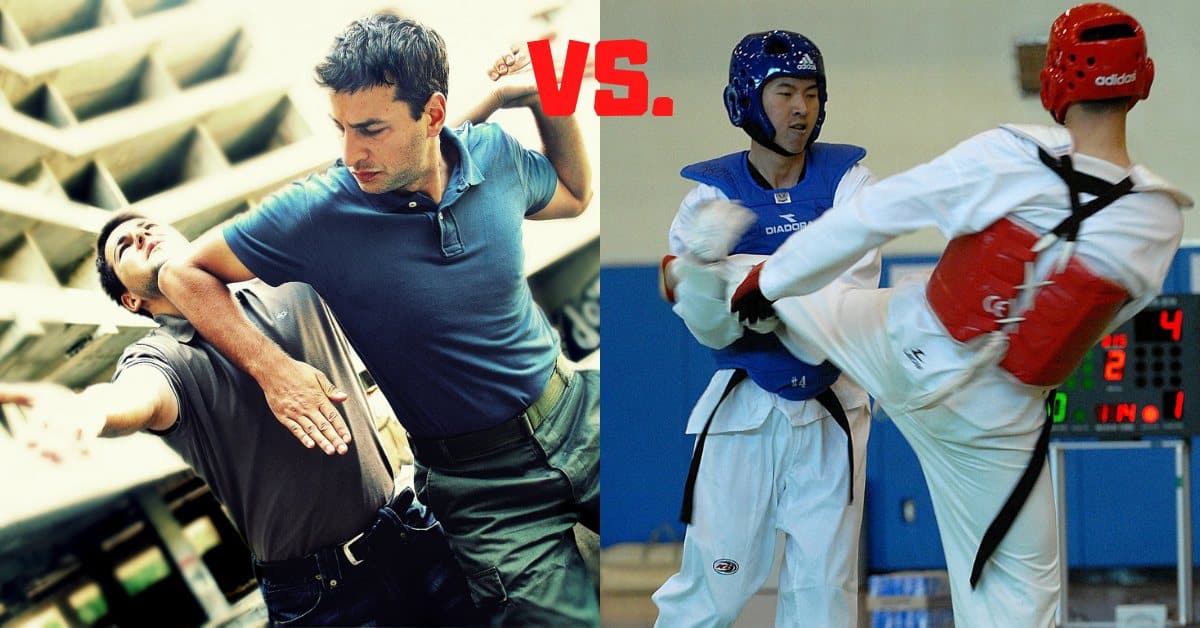When in search of the best martial arts or combat systems to train, the first couple of google searches might be quite daunting experiences. All the foreign names, apart from boxing and wrestling, there aren’t many which are readily understandable. There is no difference when it comes to Taekwondo and Krav Maga. While one of them is a martial art and the other is a combat system, they can be quite alien at first, but in this article, we plan on bringing them closer to you. We will talk about all the ways they differ, their history, effectiveness, and which one you should choose. Ultimately, our goal is to acquaint you with the differences between Krav Magaa and Taekwondo.
The differences between Taekwondo and Krav Maga are vast, seeing as Taekwondo is a Korean, mostly kicking-based martial art, whereas Krav Maga is an Israeli combat system developed for use in life or death scenarios.
There are many ways in which these systems of combat differ, and also a couple of areas where they are similar. Training either one is good for your health, confidence, and probably your self-defense skills as well, though we will dive into that later. Read on if you are interested in a comparison of Taekwondo and Krav Maga!
What Are the Differences Between Krav Maga and Taekwondo?
When looking at all the areas in which these two martial arts or combat systems differ, it is actually hard to find a place to start. Their history, style, techniques, goal, weapons, philosophy, and almost everything about them is different. We will start with some basic information about both of them and then proceed with a more detailed analysis.
Krav Maga is a military combat system developed for the Israeli Defense Forces, which saw its birth after the second world war. Hungarian-Israeli martial artist, wrestler, and boxer Imre Lichtenfeld (also known as Imi S’de-Or) is credited as the person who developed and started teaching Krav Maga to the IDF in 1948. He spent a lot of his childhood and early years in Bratislava, Czechoslovakia (Slovakia today), where the 1930-s anti-semitic riots started to threaten Bratislavan Jews. Since he was a Jew, he had to defend himself often on the streets, and this was also the time he started to take all his knowledge from all the sports and arts he has trained and started to form Krav Maga as a means to defend oneself as effectively and quickly as possible.
The main goal of Krav Maga is simple: neutralize your opponent as quickly, safely, and efficiently as humanly possible. This is why every single technique in traditional Krav Maga is extremely fast, aggressive, brutal and one could say, merciless. This doesn’t come as a surprise after Lichtenfeld’s life experience, and also the fact that Krav Maga is meant for the everyday person to be able to defend themselves as well as possible in war-stricken zones. For this reason, groin-kicks, eye-pokes, strikes to the throat, solar plexus, ears, nose, and all other weaker points are very frequent.
Taekwondo, on the other hand, was not made for war situations or to create the most efficient ways to neutralize opponents. The goal of Taekwondo (if there even is such a thing) is much rather developing the human being to its peak both physically and mentally. A lot of it is a mental practice, philosophy, and sometimes even meditation. The history of Taekwondo is also around as short as that of Krav Maga. After the second world war, there were martial arts schools opening up all around South Korea, called kwon-s. In these, martial artists of generally Chinese or Japanese martial arts backgrounds were teaching various styles and types of self-defense.
Later on, due to physical education policies, military policies, and also a nationalistic urge to create a unified Korean martial art, Choi Hong Hi developed what we now call Taekwondo. This new art was basically a combination of Chinese, Japanese, and also Korean martial arts, with an emphasis on kicking, seeing as the legs can generate a lot more speed and power than the arms can. It spread around the world, first through military demonstrations, then through the dojos that started opening up worldwide after the success of Bruce Lee films and other elements of pop culture which popularized Eastern martial arts.
The main differences between the two arts when it comes to style and movements have already been hinted at in the previous paragraphs. Krav Maga is a military combat system, solely focused on neutralizing an opponent as fast as possible, with an “all is permitted” mentality which is near the closest thing we can call Krav Maga philosophy. There are things called aggressiveness drills, which develop one’s ability to explosively express their aggression, which is key to overcoming a real-life, life-threatening situation since the hesitation that often comes with fighting is likely to get the person killed in a war-stricken environment.
Taekwondo doesn’t have the air of urgency about it that Krav Maga has. Krav Maga is also seen as a combat system which is designed to teach a layman the basics of self-defense as fast as possible, so they can defend themselves on the street. Taekwondo, on the other hand, does not have the same thing as a goal in mind, since it is focused on step-by-step, slower learning, perfecting individual techniques to layer other ones on, etc. Just like karate or jiu-jitsu.
Which Is Better for Self-defense: Krav Maga or Taekwondo?
When it comes down to actual, real-life self-defense, there is a clear winner between these two martial arts. First, we will give the reason as to why Krav Maga is the clear victor here, and then we will also discuss how that doesn’t necessarily mean Taekwondo isn’t good for self-defense since that would be a massive disservice to real Taekwondo.
Krav Maga is better for self-defense quite simply because it is made for it. It combines boxing, wrestling, martial arts, and a lot of street experience to create an easy-to-learn, intuitive, and effective self-defense combat system. The one reason Krav Maga is often criticized is that exactly due to its emphasis on quick learning, it can either leave out important details and not let students perfect any technique to be able to actually use it, or it can also result in a lot of scam dojos since the promise of learning how to protect yourself in 6 months or a year can be a good marketing strategy.
Taekwondo will also win you most street fights, as long as you are dealing with someone who doesn’t know how to fight. The reason for this important distinction is that if you face a person who has been boxing for 5 months, you might have trouble. Taekwondo places a large emphasis on kicks (though it does have strikes, throws, and grappling originally), and if a boxer were to break through and get into boxing range, they will be too close for the Taekwondo practitioner to be able to handle it properly.
Which One Should You Choose: Krav Maga or Taekwondo?
As always, this mostly depends on what is available for you. If we didn’t take into consideration your personal taste, the dojos available near you, the instructors and masters teaching there, the costs, etc., we would make the decision according to what your goals are.
If your goal is to be immersed in a type of martial art that will grant you great confidence, flexibility, physical health, kicks like a horse, and knowledge about Eastern martial art philosophy, Taekwondo is the path for you. It is still a great martial art, and if you want to go for the experience outside of the fight itself, just as much as for the fighting, it is a much better option.
On the other hand, if you are living in a more dangerous area, or you want to learn how to protect yourself or your family quickly, without any philosophy, belts, masters, degrees, etc., then Krav Maga is your best option. With Krav Magaa training, most of the time, you sign up and learn to neutralize opponents in quick and efficient ways, and you do a lot of strength and endurance training. It is basically a military boot camp, so to say.
However, even more, important than all of these are two things: your taste, and the quality of training near you. If you walk up to a dojo, look inside, and just don’t click with the movements, you take training and you don’t feel the connection, or perhaps you see that the instructor is likely a scammer or just very low quality, you should avoid the dojo. The reason we won’t elaborate on this topic is that it is really individually specific, to your life situation. Nevertheless, we do advise you not to ever give money for something you don’t think is valuable enough, so do choose your dojos carefully, and have fun sparring!

